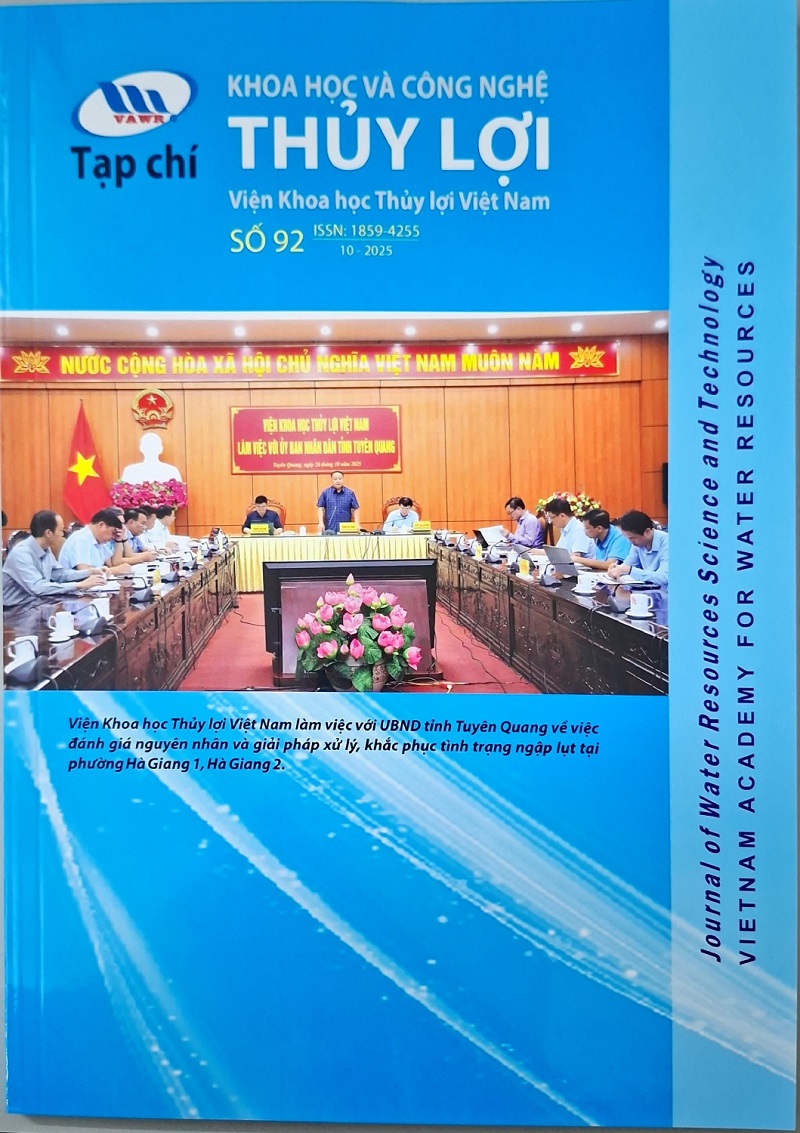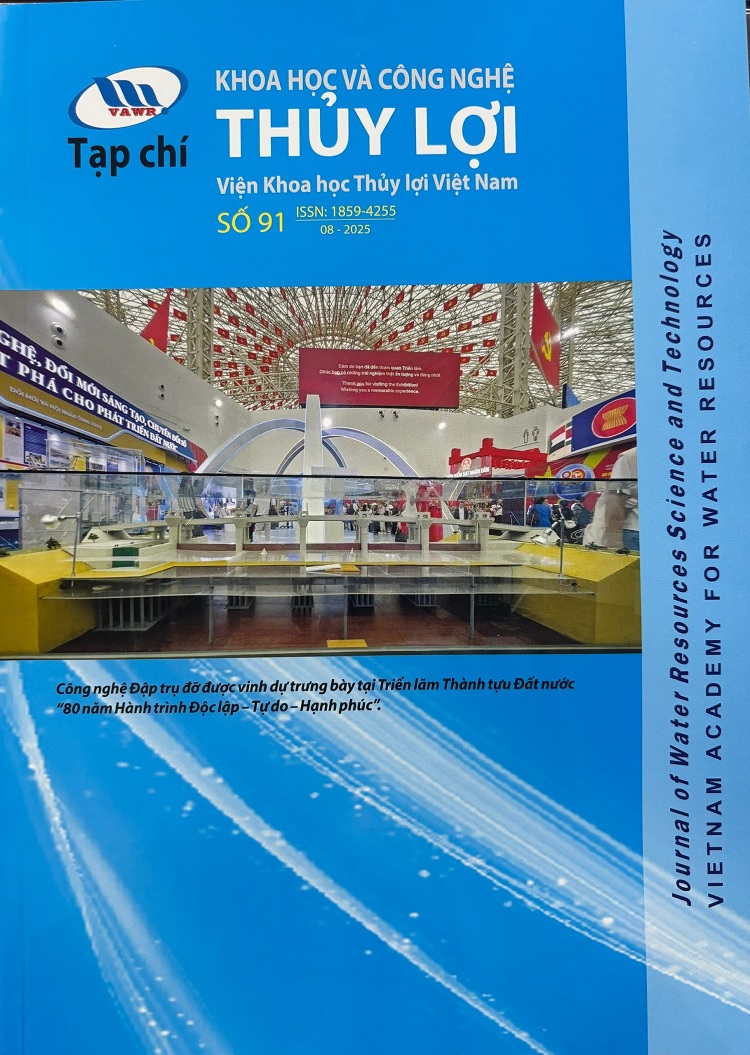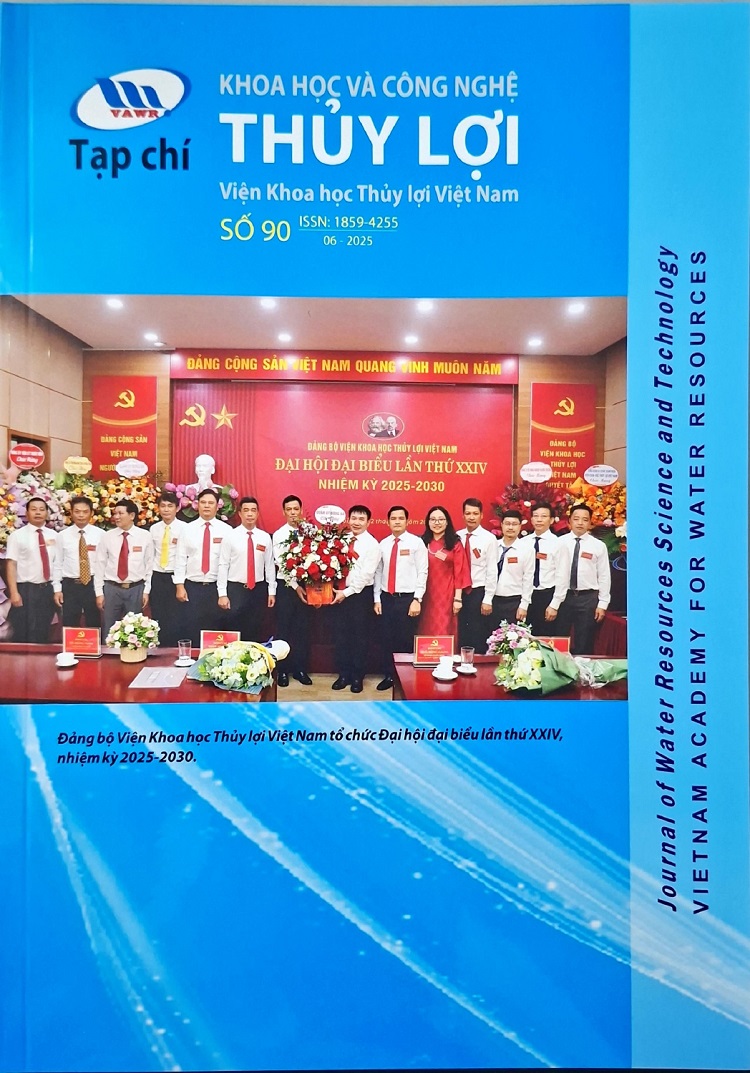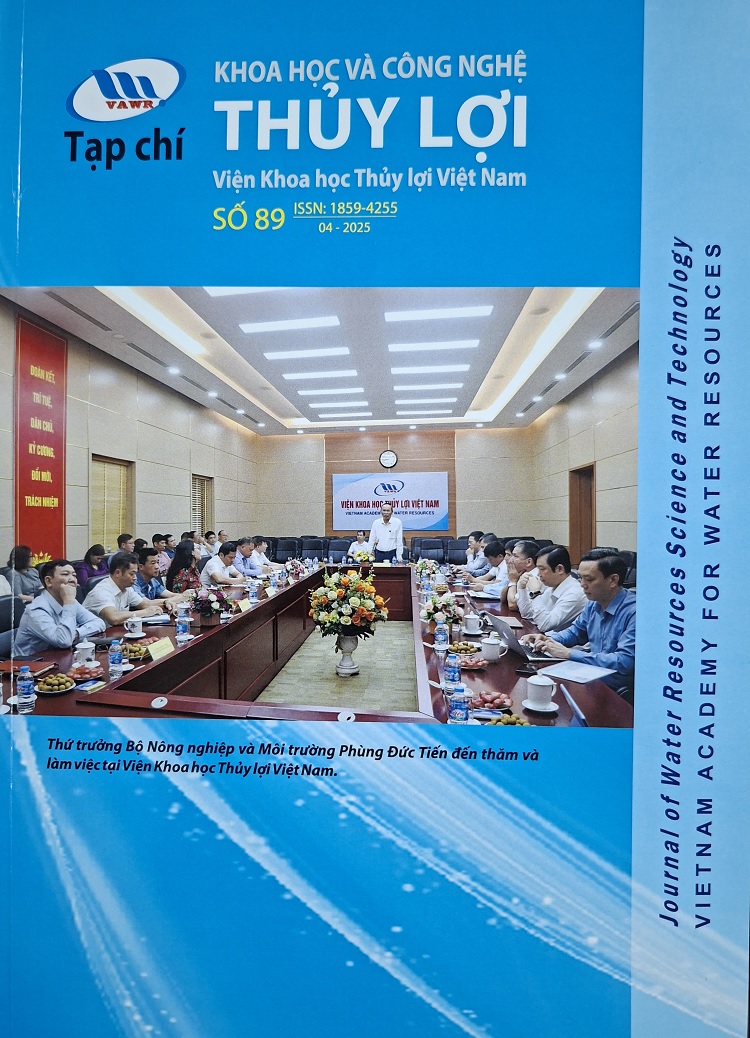Page | Title | Authors | Abstract |
2 | Initiatives on engineering solutions for Cua Tung and the northern beach of the estuary in Quang Tri province | Tran Dinh Hoa1,
Nguyen Thanh Hung2,
Phan Dinh Tuan3,
Ngô Anh Quan3 1. Vietnam Academy for Water Resources
2. Key Laboratory for River and Ocean Enginearing, Vietnam Academy for Water Resources
3. Hydraulic Construction Institute, Vietnam Academy for Water Resources | Cua Tung estuary is one of the largest estuaries of Quang Trị province in Central Vietnam. The beach here is beautiful and well-known for tourist in the past. But it has been eroded thus reducing tourist attraction. Cua Tung estuary serves as an important waterway, flushing out floodwater from Ben Hai river to the sea. The complexity of hydrodynamic regime in Cua Tung estuary and vicinity area is a main driver to cause high variation on erosion and sedimentation. Erosion occurs in the north beach area leading to reduction of open space for tourist, meanwhile deposition accumulates in the south beach area of the Cua Tung estuary. The paper provides some initiatives on engineering solutions for Cua Tung estuary area and rehabilitating measures in the northern tourism beach of the estuary. |
11 | Numerical study on the effect of perforations on the wave dissipation characteristics of “Horse-hoof-shaped hollow piles breakwaters” | Pham Duc Hung1,
Tran Dinh Hoa2 1. Hydraulic Construction Institute
2. Vietnam Academy for Water Resources | This paper investigates the effect of perforations on the wave dissipation characteristics of Horse-hoof-shaped hollow pile breakwaters (HHPBs) using the Flow3D model. The results indicate that, with varying wave parameters and sea water levels, the wave dissipation coefficient (Kl) varies between 0.59 and 0.82, the transmission coefficient (Kt) varies between 0.24 and 0.63, and the reflection coefficient (Kr) ranges from 0.33 to 0.6, as the perforated ratio on the front side changes from 9.6% to 14%, while the perforated ratio on the rear side remains constant at 11.31%. In particular, the maximum wave energy dissipation (67%) occurs when the front-rear side ratio is 12% - 11.31% and the ratio of water depth to wave height (d/H) is 0.8. Keywords: Perforated hollow pile breakwaters, wave energy dissipation, wave transmission, reflection of wave. |
19 | Application of genetic algorithm and artificial neural network for predicting the slump and compressive strength of Alkali-activated fly ash - ground granulated blast furnace slag concrete | Dinh Hoang Quan1,
Nguyen Thanh Bang2 1. Thuy Loi University
2. Vietnam Academy for Water Resources | This study presents the development of models for predicting the slump and compressive strength of Alkali-Activated Fly Ash-Ground Granulated Blast Furnace Slag (AAFS) concrete, utilizing genetic algorithm (GA) and artificial neural network (ANN) techniques. The models are based on four input parameters, include %Na2O, %GGBS, W/S, and tpaste, and a total of 178 experiments were conducted to determine the slump and compressive strength of AAFS concrete. GA was used to optimize the hyperparameters of the ANN models, and to build the Mathematic model. The ANN models achieved R-squared values of 0.93 and 0.97 for slump and compressive strength, respectively, while the Mathematic model obtained R-squared values of 0.88 and 0.95 for slump and compressive strength, respectively. The results indicate that the compressive strength of AAFS concrete is significantly affected by %GGBS, %Na2O, and W/S, while the slump is most influenced by tpaste and W/S. Furthermore, each tpaste value corresponds to two threshold values of W/S, with a slight change in W/S between the two thresholds resulting in a significant change in the slump. Similarly, each W/S value corresponds to two threshold values of tpaste, where a low tpaste value initially leads to a very low slump. However, beyond a certain threshold, the slump increases rapidly until it reaches an upper threshold value. Keywords: ANN; GA; genetic algorithm; GEP; Geopolymer; alkali-activated concrete; AAFS concrete; slag; GGBS; fly ash; compressive strength; slum |
38 | Water security: Global context and lessons learnt for Vietnam | Do Hoai Nam1,
Nguyen Cao Don1,
Le Van Chinh2,
Ha Thanh Lan3,
Ha Hai Duong1,
Vu Ngoc Chau4 1. Vietnam Academy for Water Resources
2. Thuy Loi University
3. Institute of Water Resources Planning
4. Asian Development Bank, Viet Nam Resident Mission | Water is a finite renewable resource and it is facing high stress across the globe. More than one third of the world nations now experience water shortage. This situation is getting worst and a low level of water security will pose a growing threat to societies. Water security has many different aspects and there are different approaches to enhance water security. However, they vary from definitions to practices and from nation to nation. This paper efforts to present a quick overview of water security under the global context and lessons learnt for Vietnam. Findings and recommendations are considered a good reference to inform decision makers in order to enhance the national water security. Keywords: Water security; Water security drivers; Global context and practice |
44 | The management of biosphere reserves in Vietnam: Opportunities and challenges | Le Hanh Chi1,
Vu Thuc Hien2 1. Institute of Ecology and Works Protection, Vietnam Academy for Water Resources
2. Vietnam Man and Biosphere Program National Committee | Biosphere reserves (BR) are areas of terrestrial and coastal ecosystem which promote solutions that reconcile the conservation of biodiversity with its sustainable use. Biosphere reserves serve in some ways as "living laboratories" for testing and demonstrating integrated management of land, water and biodiversity. BR is internationally recognized within the framework of UNESCO’s Man and Biosphere (MAB) Program. The MAB Program aims at solving one of the most important practical problems that people are facing today: how to strike a balance between biodiversity conservation, natural resources exploitation and socio-economic development that maintaining traditional cultural values to meet the increasing needs of people. It combines the natural and social sciences with a view to improving human livelihoods and safeguarding natural and ecosystems, thus promoting innovative approaches to economic development that are socially and culturally appropriate and environmentally sustainable. Vietnam currently has 11 BRs scattered across the length of the country and contains an important set of typical ecological, cultural and economic diversity of Vietnam. This article presents the current status of management of Vietnam's BRs, opportunities, challenges, and some recommendations on effective management of these areas. Keywords: Biosphere reserve, sustainable development, biodiversity |
53 | Sustainable finance policy for management and operation of irrigation systems: International experience and lessons for Vietnam | Le Van Chinh1 1. Thuyloi University | So far, the management of irrigation systems have basically met the actual requirements because of fundamental reforms in institutions and policies, especially since the promulgation of the Law on hydraulic works in 2017. However, limitations in the management have been remained as the current financial policy still supports farmers in the indirect form through enterprises and water user organizations. This leads to unguaranteed financial sustainability of these organizations. Therefore, it is necessary to develop a sustainable financial policy so that operational organizations of irrigation systems can afford their activities. This article analyzes and synthesizes international experiences in the development and application of sustainable finance policies in irrigation management. Principles and approaches to sustainable financing learnt from international experience are recommended to Vietnam. Keywords: Policy, sustainable finance, management and operation, irrigation systems |
65 | Reasonable number of anaerobic chambers on waste treatment plant from pig raising sector | Duong Quoc Huy1,
Vu Hai Nam2 1. Center for Training and International Cooperation Vietnam Academy for Water Resources | The pig raising industry in Vietnam currently tends to shift from a small scale to a concentrated raising with different farm-scales. Along with that trend, the problem of environmental pollution from livestock production in rural areas is becoming more and more serious due to the high density of livestock in one location while waste treatment methods are still simple (mainly biogas) and can not fully treat the pollution problem. Currently, there are many technologies applicable for waste and wastewater treatment in pig-rising sector, including: (i) natural treatment solution which is cheap but requires a lot of space (ponds, lakes, wetland, etc.); (ii) high treatment efficiency (Aerotank, MBR, JOHKASOU) using less space requirement but expensive; and (iii) semi-natural treatment technologies that combines two biological treatment processes (anaerobic, aerobic) to limit the disadvantages and take advantages of the two above mentioned technologies. This paper presents the results of research on selection of a reasonable number of anaerobic treatment modules, including: Anaerobic Baffle Reactor (ABR) and Anaerobic Filter (AF) of the wastewater treatment plan in pig-farm raising sector as a basis for standardizing the technological solution of wastewater treatment for small and medium-scaled in the North Central Region in Vietnam. Keywords: Pig raising, Wastewater treatment plant, Anaerobic, Aerobic. |
71 | Using artificial intelligence approach in predicting chloride content in concrete exposed to chloride solution | Nguyen Huu Nam1,
Tran Quoc Thanh1
Giap Van Loi2,
Tran Kim Phuong2,
Tran Van Quan2 1. Hydropower Institute & Renewables, Vietnam Academy for Water Resources
2. University of Transport and Technology | Structural corrosion due to chloride ingress is considered to be the greatest threat to buildings. Structures such as bridges, roads, infrastructure, and harbors are exposed to chloride-rich environments, either through anti-freeze salting or from the natural environment. In the marine environment, tidal and wave areas are considered to be at high risk of corrosion. The corrosion process is highly dependent on the chloride concentration in the concrete structure. Therefore, the determination of chloride concentration in concrete is meaningful and reliable. In this study, a Gradient Boosting (GB) machine learning model is proposed to predict chloride content in concrete. A dataset of 325 experimental results was collected from international literature. The results of the model are programmed and run in the Python platform, the authors use the tool of the Gradient Boosting model to predict the output parameters of chloride content in concrete. The results show that the proposed model can predict the chloride content in concrete simply and quickly, helping design engineers to predict the chloride content in advance based on the input parameters. Keywords: Artificial Intelligence (AI), Gradient Boosting (RF), chloride content, concrete, Reinforcement corrosion. |
77 | Assessment of the impacts of planning traffic bridges system across red river on Ha noi reach to the river bank erosion and river bed changes for period from 2020 to 2030 | Nguyen Thi Ngoc Nhan1,
Nguyen Hong Quang1,
Nguyen Ngoc Đang1 1. Key Laboratory of River and Coastal Engineering, Vietnam Academy for Water Resources | The article presents some results of research and evaluation about the influence of planning traffic bridges system across Red River on Ha Noi reach to the river bank erosion and river bed changes for period from 2020 to 2030. On the basis of simulation results on hydraulic models, MIKE 21FM HD-ST two-dimensional morphology simulated for the Red River section from Son Tay to Hung Yen and Duong River to Thuong Cat. Bridge piers are simulated in the model using a combination of both meshing and pier simulations. The evaluation results include topographic changes in the cross-section, longitudinal section, changes in the riverbank, and deep creeks on the studied river section before and after the construction of the bridge. Keywords: Red River, hydraulic model, MIKE 21FM HD-ST, traffic bridges, river bed evolution |
86 | Assess the applicability of anti-overtopping barrier for river dyke by foam-core composite panel (VTC.FC.3020) in Viet nam | Nguyen Chi Thanh1,
Vu Le Minh1,
Tran Thi Nga1,
Luyen Le Dieu Linh1,
Vu Van Xiem1 1. Hydraulic Construction Institute, Vietnam Academy for Water Resources | Mobile overtopping prevention technology for rivers due to floods has been applied in many countries around the world. However, it is not yet popular in developing countries like Vietnam due to the high cost and we have not yet mastered this technology. This paper introduces a new technology by using barriers with composite-coated foam panels. The structure has been completely fabricated, tested with real-life flood scenarios and deployed in the field. The results show that the structure completely meets the technical requirements and has many outstanding advantages. compared to traditional solutions (using sandbgas or reinforced concrete panels). Keywords: Overtopping; Anti-overtopping; River dyke; Foam-core; Composite |
92 | Institutional arrangements and stakeholder engagement in irrigation service pricing in Vietnam | Le Van Chinh1 1. Thuyloi University | Institutional arrangements and stakeholder engagement play an important role in the enforcement and effectiveness of irrigation service pricing policy. Recently, the irrigation service price policy in Vietnam has changed significantly in terms of content as well as application form, especially since the promulgation of the Law on Hydraulic Works. This change has greatly affected the participation of stakeholders in the setting and implementation of the irrigation service pricing policy. This study assesses the exsiting of institutional settings and stakeholder engagement in the eenforcement of the irrigation service price policy in Vietnam. Based on key findings, improvements are recommended for institutional arrangements and stakeholder engagement in irrigation service pricing policy in Vietnam. Keywords: Institutional arrangements, stakeholder engagement, irrigation service price. |
101 | The mekong river training alternatives from environmental friendly solutions | Nguyen Nghia Hung1,
Le Quan Quan1 1. Southern Institute of Water Resources Research | Due to the presence of a big river and alluvial geological conditions, the Vietnam Mekong delta (VMD) is prone to landslides, resulting in numerous vulnerable areas where erosion and land subsidence can occur frequently. In addition, the concentration of major cities and densely populated areas (such as Long Xuyen, Cao Lanh, Can Tho, Vinh Long, My Tho, Ben Tre) along rivers, which is often preferred due to their historical, economic significance, may pose a notable risk of riverbank collapse. Based on statistical data from 2019, approximately 393 areas in the VMD have been impacted by riverbank erosion, this has resulted in significant damages to both the economy and threatening human lives in the areas. Various river training alternatives for the Vietnam Mekong delta have been progressively implemented, starting with basic studies and the development of plans aimed at stabilizing river morphology. These efforts are geared towards ensuring river flow stabilization and promoting social-economic development. Among the interventions including both hard and soft solutions for river training in VMD, the article introduces a number of possible environmentally friendly solutions, such as, directing the flow, flow voltex solutions to adjust the sediment transport and riverbank protection measures. Each solution is accompanied by calculations and cost estimates, indicating their feasibility and potential for implementation. Keywords: Mekong River, River training, riverbank environment, riverbank erosion |






